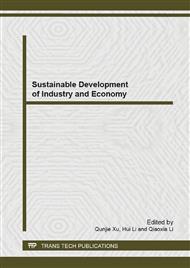p.564
p.569
p.573
p.581
p.593
p.598
p.603
p.612
p.623
Interpretive Structural Model of the International Regional Energy Cooperation
Abstract:
International regional energy cooperation is a complex system characterized by subject diversification, relationship complexity, and structural layering. This cooperation consists of the complementary resource system, market function system, and external environment system. We establish a structure model of the international regional energy cooperation by using structural principle and interpretive structural modeling. In the model, 38 elements were distributed across seven layers. The seven layers to which the elements were distributed included the key problem in the study of international regional energy cooperation. Four relation-chains surround the core elements and the external environment. The elements in each relation-chain interact with one another and behave in a coordinated manner. These findings provide the important basis for the stability of the mechanism of the international regional energy cooperation.
Info:
Periodical:
Pages:
593-597
Citation:
Online since:
December 2013
Authors:
Price:
Сopyright:
© 2014 Trans Tech Publications Ltd. All Rights Reserved
Share:
Citation:


